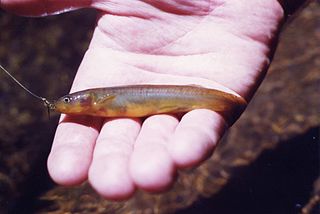
The Galaxiidae are a family of mostly small freshwater fish in the Southern Hemisphere. The majority live in Southern Australia or New Zealand, but some are found in South Africa, southern South America, Lord Howe Island, New Caledonia, and the Falkland Islands. One galaxiid species, the common galaxias, is probably the most widely naturally distributed freshwater fish in the Southern Hemisphere. They are coolwater species, found in temperate latitudes, with only one species known from subtropical habitats. Many specialise in living in cold, high-altitude upland rivers, streams, and lakes.

The mountain galaxias is a species complex of freshwater galaxiid fish found all over southeast Australia.

Galaxias olidus, the mountain galaxias, is a species of freshwater galaxiid fish widely found in southeastern Australia.
Galaxias fuscus, the barred galaxias, is a galaxiid of the genus Galaxias, a member of the Mountain Galaxias species complex group of freshwater fish, found in Australia.

The banded kōkopu is a galaxiid of the genus Galaxias, found only in New Zealand, including the Chatham and Stewart/Rakiura islands. It commonly grows to 20–25 cm, but has been recorded growing to around 30 cm. Juvenile banded kōkopu are good climbers and can climb up waterfalls and other vertical surfaces by moving into the splash zone and wriggling up the surface, using the water surface tension and their large downturned fins for grip.

Galaxias is a genus of small freshwater fish in the family Galaxiidae, and are frequently referred to as the galaxiids. These highly adaptable fish are typically found at temperate latitudes across the Southern Hemisphere.

The Golden galaxias is an endangered species of landlocked galaxiid fish belonging to the genus Galaxias. It is endemic to Lakes Crescent, Sorell, and their associated waterways located in central Tasmania, Australia.
Robert Montgomery McDowall was one of New Zealand's most prominent freshwater ichthyologists.
Galaxias aequipinnis, the East Gippsland galaxias, is a galaxiid of the genus Galaxias, a member of the Mountain galaxias species complex group of freshwater fish, found in Australia.
Galaxias arcanus, the riffle galaxias, is a galaxiid of the genus Galaxias, a member of the Mountain Galaxias species complex group of freshwater fish, found in Australia.
Galaxias gunaikurnai, the Shaw galaxias, is a galaxiid of the genus Galaxias, a member of the Mountain galaxias species complex group of freshwater fish, found in Australia.
Galaxias lanceolatus, the tapered galaxias, is a galaxiid of the genus Galaxias, a member of the Mountain Galaxias species complex group of freshwater fish, found in Australia.
Galaxias longifundus, the West Gippsland galaxias, is a galaxiid of the genus Galaxias, a member of the Mountain Galaxias species complex group of freshwater fish, found in Australia.
Galaxias mcdowalli, McDowall's galaxias, is a galaxiid of the genus Galaxias, a member of the Mountain Galaxias species complex group of freshwater fish, found in Australia.
Galaxias mungadhan, the Dargo galaxias, is a galaxiid of the genus Galaxias, a member of the Mountain Galaxias species complex group of freshwater fish, found in Victoria, Australia.
Galaxias oliros, the obscure galaxias, is a galaxiid of the genus Galaxias, a member of the Mountain Galaxias species complex group of freshwater fish, found in Australia.
Galaxias ornatus, the ornate galaxias, is a galaxiid of the genus Galaxias, a member of the Mountain Galaxias species complex group of freshwater fish, found in Australia.

Galaxias supremus, commonly known as the Kosciuszko galaxias, is a galaxiid of the genus Galaxias, a member of the Mountain galaxias species complex group of freshwater fish, found in Australia.
Galaxias tantangara, commonly known as the stocky galaxias, is a galaxiid of the genus Galaxias, a member of the Mountain galaxias species complex group of freshwater fish, found in Australia. Only discovered in 2014, the fish is classed as critically endangered, mainly because of being preyed upon by introduced species of trout.
Galaxias terenasus, the roundsnout galaxias, is a galaxiid of the genus Galaxias, a member of the Mountain Galaxias species complex group of freshwater fish, found in Australia.






